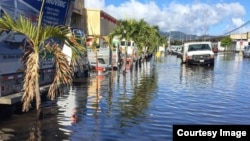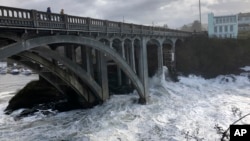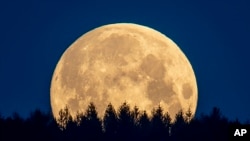A new study predicts that a changing moon cycle will increase high-tide flooding across U.S. coastal areas in the mid-2030s.
The finding is based on ocean tide data collected from 89 coastal areas covering every U.S. state and territory except for Alaska. This data was examined along with flooding records and predictions for future sea level rise stretching into the year 2080.
Research results showed that the combined effects of rising sea levels linked to climate change and natural changes in ocean tides will lead to increases in coastal flooding.
The prediction was recently reported in a study in Nature Climate Change. The study was led by members of the U.S. space agency NASA’s Sea Level Change Team. The lead researcher of the study was Phil Thompson, a member of the Sea Level Change Team and director of the University of Hawaii’s Sea Level Center.
Thompson said in a statement he expects the biggest increases to happen along the U.S. Pacific and Gulf of Mexico coastlines, which include Hawaii and other Pacific islands. This is important because this is where high-tide flooding goes from being mostly “a local or regional issue and becomes a national issue affecting a majority of our nation’s coastlines,” he said.
The researchers note that many U.S. coastal areas, especially along the Atlantic coast, are already experiencing such flooding. High-tide flooding happens when tides reach anywhere from 0.5 meters to 0.6 above the daily average high tide, says the National Oceanic and Atmospheric Administration (NOAA).
NOAA reported more than 600 incidents of this kind of flooding -- also known as “sunny day” flooding -- in 2019. Such activity is expected to worsen and lead to longer lasting floods as high tides increase in the future and sea levels keep rising.
Ben Hamlington was a co-writer of the study. He is with NASA’s Jet Propulsion Laboratory in California and also the leader of the Sea Level Change Team. He said in a statement the findings can be an important resource for U.S. coastal planners who may be centered more on preparing for extreme events rather than more high-tide flooding. For planning purposes, “it’s important to know when we’ll see an increase,” Hamlington said.
Thompson agrees that results of the study can be used by scientists, engineers and government officials who are used to preparing for rare, severe weather events such as a 100-year storm. “But we demonstrate that it is important to plan for extreme months or seasons during which the number of flooding episodes, rather than the magnitude, is exceptional,” he said.
How the moon changes tides
The prediction of increased high tides starting in the mid-2030s is linked to a normal moon cycle. NASA says the cycle -- which affects how Earth lines up with the moon and the sun -- changes our planet’s gravitational pull. This, in turn, affects ocean tides.
The cycle causes “a regular wobble in the moon’s orbit that takes 18.6 years to complete,” NASA explains. In half of the moon’s cycle, it causes high tides on Earth to be lower than normal and low tides to be higher than normal. In the other half of the cycle, high tides get higher and low tides get lower.
Currently, NASA says the moon is in the cycle that intensifies high tides. And while there have been issues with high-tide flooding, there has not been enough sea level rise to cause high tides “to regularly top” flooding levels, the researchers said.
But the next time the cycle comes around again, in the mid-2030s, sea level rise “will have been at work” during those years, NASA noted. The higher seas, combined with the new moon cycle, “will cause a leap in flood numbers on almost all U.S. mainland coastlines, Hawaii, and Guam.”
Such flooding could leave people in cities dealing with floods “every day or two,” the research team predicts.
I’m Bryan Lynn.
Bryan Lynn wrote this story for VOA Learning English, based on reports from NASA and the University of Hawaii. Susan Shand was the editor.
We want to hear from you. Write to us in the Comments section, and visit our Facebook page.
____________________________________________________________
Words in This Story
tide – n. the regular rise and fall in the level of the sea
episode – n. a single event or period of time
magnitude – n. the large size of importance of something
regular – adj. something that happens often
wobble – v. to move from side to side
leap – n. a sudden increase or improvement
https://news.google.com/__i/rss/rd/articles/CBMid2h0dHBzOi8vbGVhcm5pbmdlbmdsaXNoLnZvYW5ld3MuY29tL2Evc3R1ZHktbW9vbi1jeWNsZS1jaGFuZ2UtdG8taW5jcmVhc2UtdXMtY29hc3RhbC1mbG9vZGluZy1pbi1taWQtMjAzMHMvNTk2NzMyOS5odG1s0gF5aHR0cHM6Ly9sZWFybmluZ2VuZ2xpc2gudm9hbmV3cy5jb20vYW1wL3N0dWR5LW1vb24tY3ljbGUtY2hhbmdlLXRvLWluY3JlYXNlLXVzLWNvYXN0YWwtZmxvb2RpbmctaW4tbWlkLTIwMzBzLzU5NjczMjkuaHRtbA?oc=5
2021-07-18 22:01:40Z
52781736284343




Tidak ada komentar:
Posting Komentar